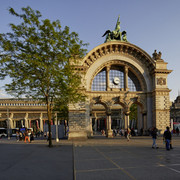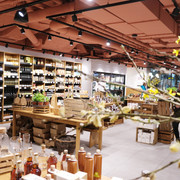How would you like to arrive?
- 2:00 h
- 4.24 km
- 30 m
- 31 m
- 432 m
- 445 m
- 13 m
- Start: Lucerne, Tourist Information (Station)
What do you want to see while in Lucerne? The Chapel Bridge with its gabled paintings of old battles and the adjacent quaint quarters with little streets ranging and changing from silence to abundant liveliness? The curiosities of the museums, the treasures of the many churches? Take an easygoing walk through a maze of small streets, bridges, promenades and plazas dominated by countless historical towers, fountains and frescoed buildings. You'll spend unforgettable days in this fair city of ours.
Interesting Sights:
Culture and Convention Center Lucerne (KKL Luzern)
The Culture and Convention Center Lucerne on Europa Square is the work of the Parisian architect Jean Nouvel. The concert-hall (1840 seats) is one of the finest concert halls in the world. The Lucerne Hall, the Convention Center with the Auditorium and the Museum of Art are likewise part of this sensational construction. Public and personal guided tours on request.
Chapel Bridge
Constructed first half of the 14th century as a part of the city's fortifications. Named after nearby St. Peter's chapel. The paintings that were added in the 17th century illustrate scenes of Swiss and local history including the biographies of the city's patron saints, Leodegar and Mauritius.
Water Tower (Wasserturm)
This octagonal over 34 meters high (111,5 ft.) tower was built ca. 1300 as part of the city wall. Used as archives, treasury, prison and torture chamber. Lucerne's trademark and the most photographed monument in Switzerland.
Jesuit Church (Jesuitenkirche)
First large sacral Baroque building in Switzerland. Constructed in 1666 by Father Christoph Vogler for the Jesuits. The vault was redecorated in the mid-18th century. The original vestments of Brother Klaus, a famous Swiss patron, are stored in the inner chapel.
Ritterscher Palace
Erected in 1557 for Lucerne's mayor Lux Ritter as a private residence in the Italian Renaissance style. The city later completed the work. Living quarters for the Jesuits called to Lucerne in 1574. Today Cantonal seat of government.
Franciscan Church (Franziskanerkirche)
Typical medieval mendicant architecture. Built second half of 13th century, Gothic style. Most ornate pulpit in Switzerland from the period between Renaissance and Baroque era. Flag
frescoes represent Lucerne's conquests in the Middle Ages.
Water Spikes (Nadelwehr)
A unique sight from the technical standpoint. The so-called "spikes" are lowered or withdrawn by hand into the water to regulate the water level. It replaced in 1859-60 the Reuss steps that chanelled the water over the citymills.
Spreuer Bridge
Was completed in 1408 as a part of the city fortification. Between 1626 and 1635 Kaspar Meglinger added 67 paintings that represent the «Dance of Death». Called the Spreuer bridge because chaffs of wheat were thrown in the river here.
Musegg Wall (Museggmauer)
A part of the rampart walls built in 1386. Wall almost entirely intact. Three towers are open to the public: Schirmer, Zyt and Männli. The oldest city clock built by Hans Luter in 1535 is on the Zyt tower. This clock is privileged to chime every hour one minute before all the other city clocks. (Closed All Saints Day till Good Friday)
Old City Squares (Weinmarkt / Hirschenplatz / Kornmarkt / Kapellplatz)
Historical, frescopainted buildings border the old city on the right bank of the Reuss at a few picturesque squares. The Weinmarkt, where the Lucerns swore a federal oath with Uri, Schwyz and Unterwalden, is especially attractive. So are the Hirschenplatz square, named after an old inn from the Middle Ages, and the Kornmarkt square which features the Town Hall and beautifully painted Pfistern guildhall.
Town Hall (Rathaus)
Built between 1602 and 1606 by Anton Isenmann in Italian Renaissance style and covered with a Bern farmhouse roof for weather purposes. The open arcades facing the Reuss still serve today as a weekly marketplace. The Kornschütte hall above an earlier trading goods store, is used today as a concert and exhibition locale.
Lion Monument (Löwendenkmal)
«The dying Lion of Lucerne» is one of the world's most famous monuments. It was hewn out of natural rock in memory of the heroic death of the Swiss mercenaries at the Tuileries
in 1792. Globetrotter Mark Twain described the Lion of Lucerne as «the
saddest and most moving piece of rock in the world».
Hof Church (Hofkirche)
Main cathedral for the city population and religious center St. Leodegar and Mauritius. Benedictine monastery founded here in the 8th century. Fire destroyed church in 1633. Rebuilt 1645. Is the most important Renaissance church building in Switzerland. Especially noteworthy are the facade, Mary's altar (with a relief panel from 1500) and the souls' altar.
Note(s)
The version A (Variante A) can only be toured by those who are steady on their feet.
See also
Tourist Information Luzern
im Bahnhof
Zentralstrasse 5
6003 Luzern
Tel: +41 (0)41 227 17 17
Internet: www.luzern.org
E-Mail: info@luzern.org
Waypoints
Good to know
Best to visit
Directions
Tour information
Stop at an Inn
Author
Carla Hendry
Organization
Region Luzern-Vierwaldstättersee
Nearby




![[Translate to Englisch:] Gästekarte Luzern Gästekarte Luzern](https://www.luzern.com/fileadmin/_processed_/6/4/csm_SGV_2017_aa603a6780.jpg)
















